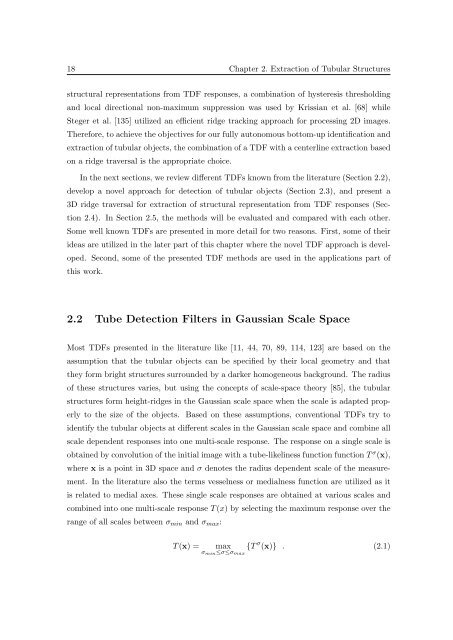Segmentation of 3D Tubular Tree Structures in Medical Images ...
Segmentation of 3D Tubular Tree Structures in Medical Images ...
Segmentation of 3D Tubular Tree Structures in Medical Images ...
Create successful ePaper yourself
Turn your PDF publications into a flip-book with our unique Google optimized e-Paper software.
18 Chapter 2. Extraction <strong>of</strong> <strong>Tubular</strong> <strong>Structures</strong><br />
structural representations from TDF responses, a comb<strong>in</strong>ation <strong>of</strong> hysteresis threshold<strong>in</strong>g<br />
and local directional non-maximum suppression was used by Krissian et al. [68] while<br />
Steger et al. [135] utilized an efficient ridge track<strong>in</strong>g approach for process<strong>in</strong>g 2D images.<br />
Therefore, to achieve the objectives for our fully autonomous bottom-up identification and<br />
extraction <strong>of</strong> tubular objects, the comb<strong>in</strong>ation <strong>of</strong> a TDF with a centerl<strong>in</strong>e extraction based<br />
on a ridge traversal is the appropriate choice.<br />
In the next sections, we review different TDFs known from the literature (Section 2.2),<br />
develop a novel approach for detection <strong>of</strong> tubular objects (Section 2.3), and present a<br />
<strong>3D</strong> ridge traversal for extraction <strong>of</strong> structural representation from TDF responses (Section<br />
2.4). In Section 2.5, the methods will be evaluated and compared with each other.<br />
Some well known TDFs are presented <strong>in</strong> more detail for two reasons. First, some <strong>of</strong> their<br />
ideas are utilized <strong>in</strong> the later part <strong>of</strong> this chapter where the novel TDF approach is developed.<br />
Second, some <strong>of</strong> the presented TDF methods are used <strong>in</strong> the applications part <strong>of</strong><br />
this work.<br />
2.2 Tube Detection Filters <strong>in</strong> Gaussian Scale Space<br />
Most TDFs presented <strong>in</strong> the literature like [11, 44, 70, 89, 114, 123] are based on the<br />
assumption that the tubular objects can be specified by their local geometry and that<br />
they form bright structures surrounded by a darker homogeneous background. The radius<br />
<strong>of</strong> these structures varies, but us<strong>in</strong>g the concepts <strong>of</strong> scale-space theory [85], the tubular<br />
structures form height-ridges <strong>in</strong> the Gaussian scale space when the scale is adapted properly<br />
to the size <strong>of</strong> the objects. Based on these assumptions, conventional TDFs try to<br />
identify the tubular objects at different scales <strong>in</strong> the Gaussian scale space and comb<strong>in</strong>e all<br />
scale dependent responses <strong>in</strong>to one multi-scale response. The response on a s<strong>in</strong>gle scale is<br />
obta<strong>in</strong>ed by convolution <strong>of</strong> the <strong>in</strong>itial image with a tube-likel<strong>in</strong>ess function function T σ (x),<br />
where x is a po<strong>in</strong>t <strong>in</strong> <strong>3D</strong> space and σ denotes the radius dependent scale <strong>of</strong> the measurement.<br />
In the literature also the terms vesselness or medialness function are utilized as it<br />
is related to medial axes. These s<strong>in</strong>gle scale responses are obta<strong>in</strong>ed at various scales and<br />
comb<strong>in</strong>ed <strong>in</strong>to one multi-scale response T (x) by select<strong>in</strong>g the maximum response over the<br />
range <strong>of</strong> all scales between σ m<strong>in</strong> and σ max :<br />
T (x) =<br />
max {T σ (x)} . (2.1)<br />
σ m<strong>in</strong> ≤σ≤σ max















